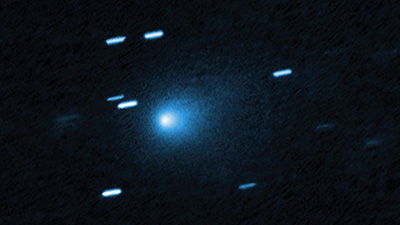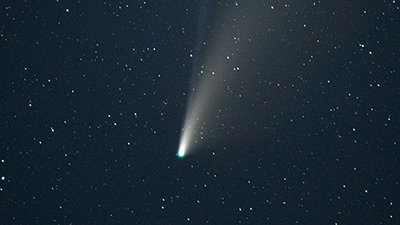
Comets Had a Role In Forming Earth’s Oceans, Study Shows
Kuiper comets capture credit for watering the early Earth.
News Source
- Space.com: “Comets Created Earth’s Oceans, Study Concludes”
Evolutionary scientists believe that water was needed for the evolution of life but have long debated how the early earth could have been supplied with that water. Many have suggested that asteroids bombarding the earth about 4 billion years ago brought organic compounds and water, supplying the raw materials for life to evolve.1 Now Paul Hartogh’s team from the Max Planck Institute for Solar System Research, analyzing data from the Herschel Space Observatory, has determined that comets from the Kuiper belt may have been that ancient source.
So why do these scientists suggest an extraterrestrial water source? Believing that the nebular hypothesis explains the origin of the earth, Max Planck Institute’s planetary scientist Paul Hartogh explains, “When the Earth formed it was so hot that most volatiles escaped to space, so when the Earth cooled down it was dry. Water and other volatiles must have been delivered at a later stage.”
In principle, water from a particular source should match that source in the ratio of elemental isotopes it contains.
In principle, water from a particular source should match that source in the ratio of elemental isotopes it contains. “Heavy water” is water in which the hydrogen isotope is deuterium, and earth’s water today contains about 1,558 deuterium atoms to every 10 million ordinary hydrogen atoms.
Asteroids have been proposed as possible sources for earth’s original supply of water since deuterium/hydrogen ratios in carbon-rich meteorites thought to be asteroid fragments are in the right neighborhood: 1,400 deuterium atoms per 10 million regular hydrogen atoms compared to 1,558 in terrestrial water. Comets, because they are typically icy, have also been proposed as the primordial water source. However, previous measurements of deuterium ratios in six comets revealed deuterium ratios of about 2,960 per 10 million, twice the amount seen on earth. Researchers have suggested that these six comets originated from the Oort cloud at the outer fringes of our sun’s gravitational influence.
Now, the Herschel Space Observatory has measured the deuterium/hydrogen ratio in comet Hartley 2 and found a near match for earth at 1,610 to 10 million. Hartogh, lead author of a report just published in Nature, says, “With our finding it may be that more than 10 percent and perhaps all water on earth possibly stems from comets. It may be that all bodies in the inner solar system get their water from these comets. Sampling a larger number of comets for their deuterium-hydrogen ratios could shed light on the matter.”
Hartogh, expressing satisfaction with the single measurement obtained during Hartley 2’s fly-by, says, “With our one data point, we showed that comets can have Earth-like D/H ratios and therefore a larger amount of water may have been delivered by comets, perhaps all. . . . At the time of the Solar System formation there may have been a large reservoir of such comets with the correct ratio that bombarded the Earth.”2
The astronomers believe that Hartley 2 originated from the Kuiper belt, a collection of trans-Neptunian objects orbiting in the outer reaches of our solar system. Secular cosmology maintains that the Kuiper belt contains debris from the explosive origin of the solar system.
The “nebular hypothesis” is believed by many secular scientists to explain our solar system’s origin. They maintain that our solar system formed 4.6 billion years ago from a hot cloud of dust and gas. The solar system supposedly formed as dust orbiting the newborn sun stuck together to make primordial planets. Continuing to collide, some debris stuck together while some shattered. One of the problems with the nebular hypothesis is the notion that colliding stardust would stick together rather than bouncing off or exploding on impact. Another problem is that the nebular hypothesis violates the physical laws of conservation of momentum. Nevertheless, in an effort to avoid a biblical explanation for the origin of all things—in other words, God as Creator—many cling to this explanation despite its aberrant physics.
While the isotope ratios in the comets and asteroids are of scientific interest, they tell us nothing about the origin of the solar system.
While the isotope ratios in the comets and asteroids are of scientific interest, they tell us nothing about the origin of the solar system. In fact, other recent isotopic data has punched more holes in the nebular hypothesis. (Read more about the isotopes in solar wind at “Sun and Planets Built Differently Says Nasa.”) Furthermore, while the Kuiper belt is observable, there is not proof that it is the source of short-period comets like Hartley 2. (Read more about it at “Kuiper Belt Objects: Solution to Short-Period Comets?”) The Oort cloud is a hypothetical cosmological birthplace for long-period comets that could not otherwise still exist in the time frame demanded by big bang cosmology. The Oort cloud has never been observed. The Bible explains the origin of the water on earth and the origin of the entire universe. And the time of this Creation, about six thousand years ago, does not exceed maximum comet lifespans or demand a hypothetical birthplace to replenish them.
The Bible in the book of Genesis provides God’s eyewitness account of the origin of the universe. God, as the Creator, has told us that He spoke the earth into existence about six thousand years ago. He made the earth with its generous supply of water, not as a hot molten world that would boil away its water. After providing the earth with an atmosphere, dry land, and plant life, He created the solar system and the other stars. He specifies that He made the sun, moon, and stars on the fourth day of Creation week. There is no way to blend the Genesis account of Creation with secular ideas of cosmology such as the big bang and the nebular hypothesis without calling God a liar.
Further Reading
- Get Answers: Astronomy
For More Information: Get Answers
Remember, if you see a news story that might merit some attention, let us know about it! (Note: if the story originates from the Associated Press, FOX News, MSNBC, the New York Times, or another major national media outlet, we will most likely have already heard about it.) And thanks to all of our readers who have submitted great news tips to us. If you didn’t catch all the latest News to Know, why not take a look to see what you’ve missed?
(Please note that links will take you directly to the source. Answers in Genesis is not responsible for content on the websites to which we refer. For more information, please see our Privacy Policy.)
Footnotes
- Ron Cowen, “Comets Take Pole Position as Water Bearers,” Nature, October 5, 2011, doi:10.1038/news.2011.579.
- Ibid.
Recommended Resources

Answers in Genesis is an apologetics ministry, dedicated to helping Christians defend their faith and proclaim the good news of Jesus Christ.
- Customer Service 800.778.3390
- Available Monday–Friday | 9 AM–5 PM ET
- © 2025 Answers in Genesis




